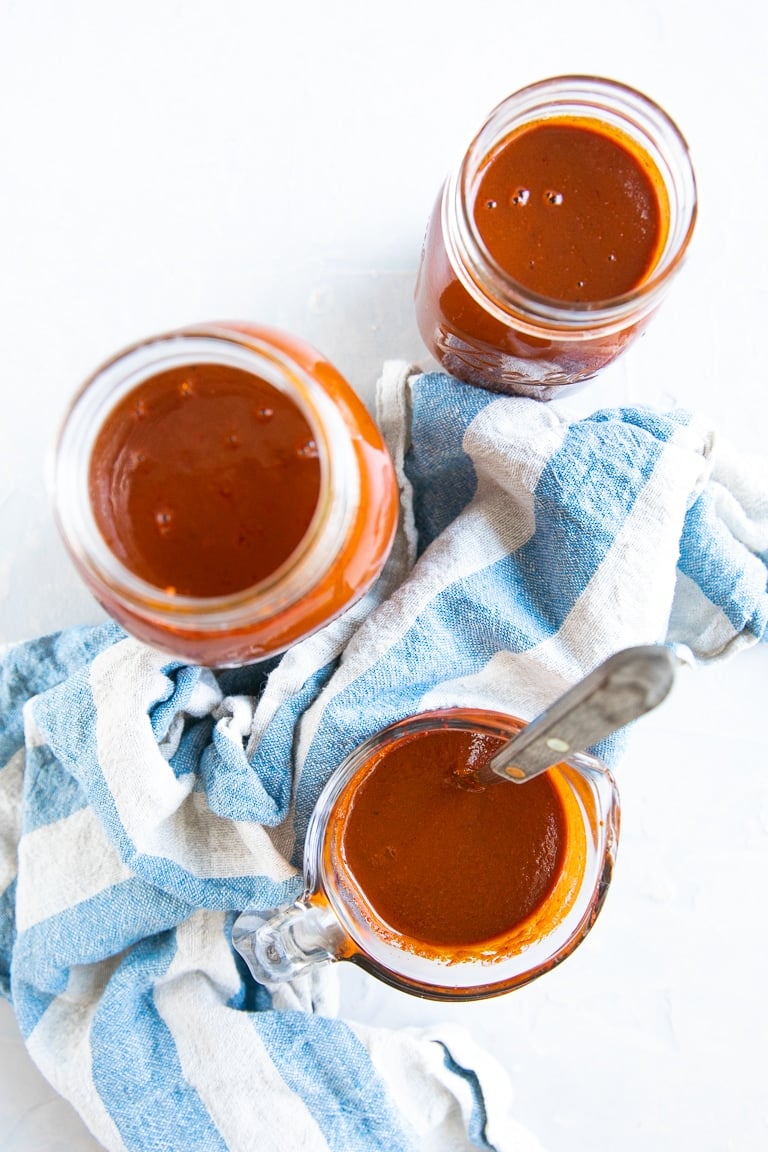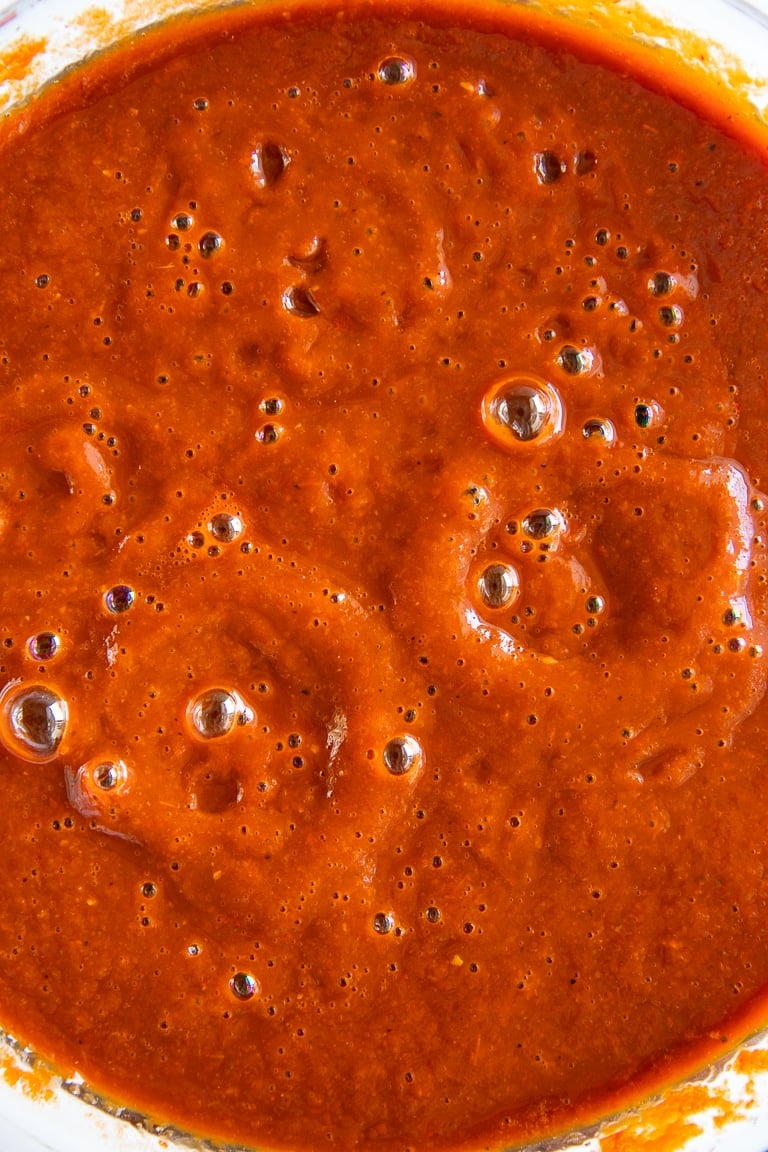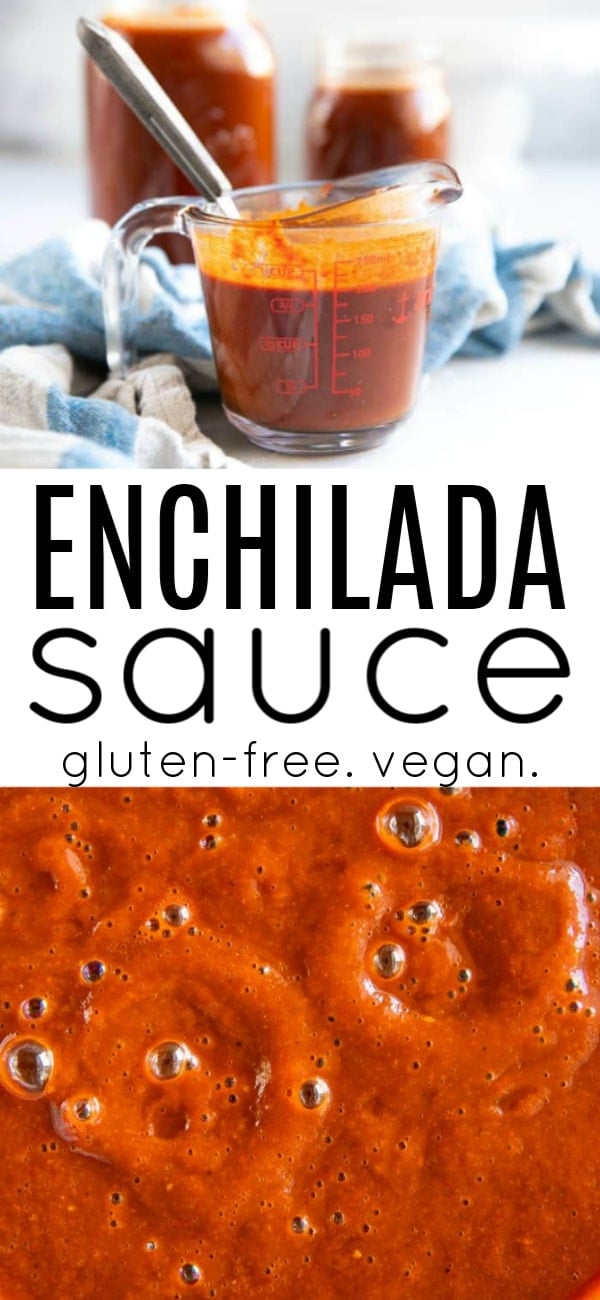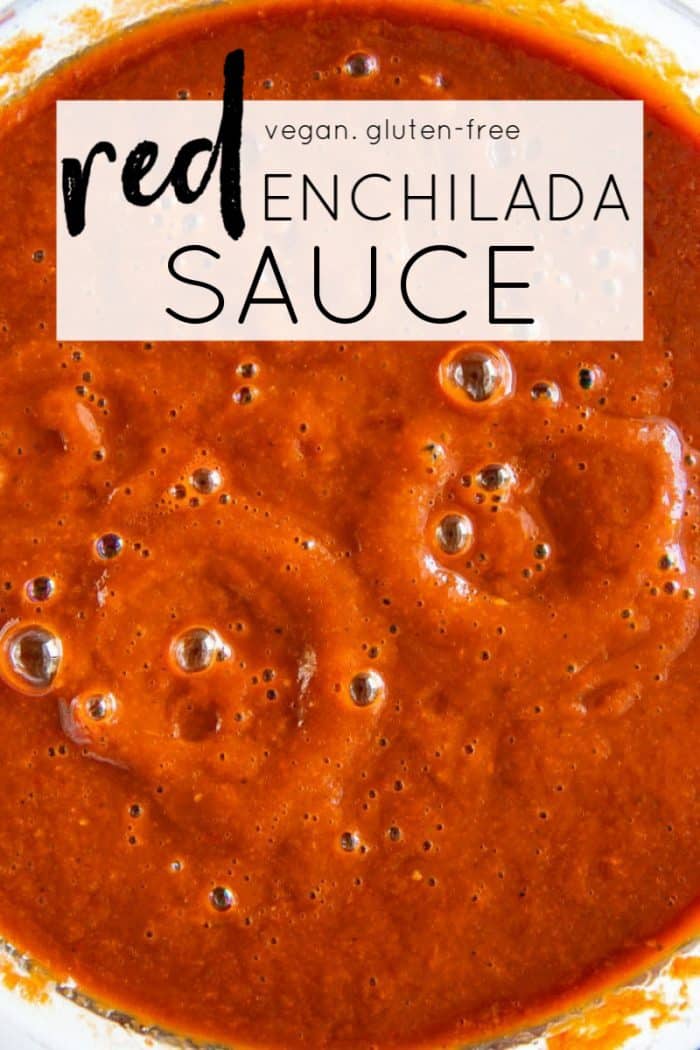This post may contain affiliate links. Please read our disclosure policy.
This Homemade Enchilada Sauce is a million times better than any store-bought version and super easy to make! Bold, delicious, and full of beautifully complex flavors, learn how to make this delicious red enchilada sauce and use in all of your favorite Mexican recipes.

Best Enchilada Sauce Recipe
Making your own easy enchilada sauce right at home is super easy and cost-efficient and tastes way better than premade canned enchilada sauce. Like this homemade mole sauce, you’ll need approximately an hour or so to bring it all together, but the results are completely worth the effort.
Popular in Mexico and the American Southwest, this red enchilada sauce is made from dried chili peppers, roasted onions, tomatoes, garlic, and a handful of other super simple, preservative-free pantry essentials. Way more flavorful than anything you’ll find at the grocery store, this homemade version is is just like what you’ll find at your favorite Mexican restaurant and is free of MSG, preservatives, or any other unknown ingredients.
A perfect combination of tangy, smoky, salty, and spicy, this delicious red enchilada sauce is perfect with beef or chicken enchiladas, as a base in your favorite chicken tortilla soup, added to burritos, or simply drizzled on top of your favorite taco recipe. It’s also vegan, dairy-free, and gluten-free!

What is Enchilada Sauce
There are countless versions of enchilada sauce on the internet. Some include a roux made with all-purpose flour and oil with dried chili powder, while other, more authentic enchilada sauce recipes (like this one), are made from whole dried chiles, onions, garlic, fresh tomato, Mexican oregano, and ground cumin, a little sugar, and Mexican chocolate (optional).
- Dried ancho chile peppers: Ancho chile peppers are the dried, ripened poblano peppers (since the dark green poblano we know is actually the unripened version of this not-so spicy chile pepper). Mild in heat, and somewhat sweeter in taste compared to poblano peppers, ancho chile peppers are a common ingredient in many Mexican sauces and recipes.
- Dried guajillo chile peppers: The dried form of mirasol chilis, guajillo chile peppers are the second most popular dried chilies to be used in Mexican cuisine and are considered mild to medium in heat.
- Dried Arbol chile peppers: The hottest of the three chiles, Arbol chile peppers start out green, turn red as they ripen, and turn an even deeper red once dried. Given their somewhat unpredictable heat level, I typically err on the side of caution when adding these chiles to sauces and stews.
- Dried Mexican oregano: Unlike the Greek and Mediterranean versions of oregano that most of us are likely accustomed to, Mexican oregano has notes of citrus and mild licorice rather than savory, earthy, and peppery.
- Chocolate (optional): Not too much. After all, we’re not making Mole Sauce. And definitely, please, do not add milk chocolate. All you need is a small piece or two of bittersweet or Mexican chocolate.

How to Make Enchilada Sauce
It’s surprisingly easy to make enchilada sauce from scratch. You will need a heavy-bottomed skillet (I recommend a cast-iron skillet for this), blender, pot, and jars with tight-fitting lids to store all your beautiful sauce. You may also want to use a pair of gloves when handling the chiles as their heat level is often unpredictable.
1. Roast the chiles: Roast the whole dried chiles in a dry, heavy-bottomed pan or skillet set over medium heat for 1-2 minutes on each side. You will not really see any visible changes in color as you roast them, so keep a close watch as roasting for too long will result in a bitter-tasting sauce. Remove from the skillet.
2. Bring the water, chicken stock, or vegetable broth to a boil: If you have chicken or vegetable stock, I recommend using one of those as it will offer more flavor than water. As you wait for it to boil, move on to the next step.
3. Remove the seeds and soak: Gently remove the stems and slice each chile open lengthwise. Remove the seeds and membranes (the spicy part of the chili) and discard. Transfer the chiles to a medium bowl.
4. Once the water (or broth) reaches a boil (step #2), carefully pour the water over the dried chile peppers. Cover the bowl and allow the chiles to soak for at least 30 minutes.

5. Roast the vegetables: As the chile peppers soak, return the dry skillet to medium-high heat. Add the onion, tomatoes, and garlic cloves. Allow the vegetables to cook until lightly browned on each side, approximately 3-4 minutes on each side.

6. Combine and blend: Transfer the onion, tomatoes, garlic cloves, and peppers (once softened) to the bowl of a large blender. Add the soaking liquid, salt, Mexican oregano, and ground cumin. Blend until completely smooth.

7. Cook the Sauce: Heat 1 tablespoon of vegetable oil (or canola oil) in a medium pot over medium heat. Add the blended chile pepper sauce and bring to a low simmer. Reduce heat to low and simmer, uncovered, for approximately 25 minutes. If the sauce becomes too thick, add a little more water or broth, as needed.
8. Season to taste: The sauce will be quite bitter at this point. While most enchilada sauces are not meant to taste super sweet or super salty (or super delicious on their own), you can easily balance some of the bitterness with salt, sugar, and a small piece or two of semi-sweet chocolate (be sure to add the chocolate at the end of cooking).
Recipe Tips
- Use whole dried peppers, not pre-ground chili powder. There really is no comparison between the two.
- Use fresh garlic, onions, and tomatoes. Unfortunately, onion powder, garlic powder, or dried cayenne pepper (for extra heat) just won’t give the authentic results we’re looking for.
- Dried Arbol chiles are the spiciest of the three dried peppers that we’re adding to our sauce. Although they are the smallest, take care when deciding how many to add to your sauce- especially if you’re sensitive to spicy foods.
- If you find that your sauce isn’t blended completely, simply pour it through a fine-mesh strainer which will separate any large bits from the sauce.
- By using whole dried chiles, you will not need to add any all-purpose flour or cornstarch, nor will you need to make a roux.
- Chocolate is a flavor enhancer, not a main ingredient. Use sparingly and add to the sauce right at the end.
How to Store Enchilada Sauce
Keep any leftover homemade red enchilada sauce in an airtight container and in the refrigertor for up to one week.
You may also freeze enchilada sauce. To do so, first allow your sauce to reach room temperature before transferring to freezer-safe jars or reusable bags (I love these reusable silicone bags). Seal and transfer to the freezer for up to 4 months.
To thaw, transfer to the refrigerator overnight, or place the jar or container in a bowl filled with warm water to help speed up the thawing process.

How to Serve
Often used as a seasoning, I love to add enchilada sauce to my favorite stews and soups, like this Instant Pot chicken enchilada soup. Sometimes I’ll mix enchilada sauce with homemade pico de gallo and serve it with chips and fresh avocado or I’ll bake with beans and cheese for a warm, gooey, delicious party dip!
Of course, classic chicken, veggie, or beef enchiladas are always winners, but why not try simmering eggs in your homemade sauce and topping with shredded cheese? Serve with warm corn tortillas, sour cream, and homemade guacamole.
More delicious Mexican food recipes to try next,
- Caldo de Pollo Recipe (Mexican Chicken Soup)
- Albondigas Soup Recipe (Mexican Meatball Soup)
- Refried Beans (How to Make Refried Black Beans)
- Classic Margarita Recipe (How to Make a Margarita)
- 20-Minute Ground Beef Tacos Recipe
- Mexican Birria Recipe (How to Make Birria)
- Pozole Rojo Recipe (Red Posole)

Have you tried making homemade enchilada sauce?
Tell me about it in the comments below! I always love to hear your thoughts. And tag me #theforkedspoon on Instagram if you’ve made any of my recipes, I always love to see what you’re cooking in the kitchen.

Homemade Enchilada Sauce Recipe
Ingredients
- 5 ounces dried ancho chile peppers
- 5 ounces dried guajillo chile peppers
- 4-6 dried arbol chile peppers, use more or less depending on heat tolerance
- 5 cups boiled water , (or chicken or vegetable broth)
- 2 white onions, halved
- 4 large tomatoes, quartered
- 6 cloves garlic
- 1 teaspoon salt, plus more to taste
- 2 teaspoon dried Mexican oregano
- 1 teaspoon ground cumin
- 1 tablespoon oil
- 1 tablespoon granulated sugar, more or less to taste
- semi-sweet chocolate, optional, to taste
Instructions
- Roast the chiles – start by roasting your chiles in a dry, heavy-bottomed pan or skillet (I love my cast-iron skillet for this) set over medium heat. Simply add the dried chile peppers and roast for 1-2 minutes on each side. Do not over-toast your dried chilis as it will result in a bitter-tasting sauce. Remove from the skillet.
- Bring the water or chicken stock to a boil. As you wait for it to boil, move on to the next step.
- Remove seeds and soak – Using gloves (highly recommended!), gently remove the stems and slice heat chile open lengthwise. Remove the seeds and membranes (the spicy part of the chili) and discard. Transfer the chiles to a medium bowl.
- Once the water (or broth) reaches a boil, carefully pour the water over the dried chile peppers. Cover the bowl and allow chiles to soak for at least 30 minutes.
- Roast the vegetables – As the chile peppers soak, return the skillet to medium-high heat. Add the onion, tomatoes, and garlic cloves. Allow the vegetables to cook on each side until lightly browned on each side, approximately 3-4 minutes.
- Blend it all together. Transfer the onion, tomatoes, garlic cloves, and peppers (once softened) into the bowl of a large blender. Add the soaking liquid, salt, Mexican oregano, and ground cumin. Blend until completely smooth (see note).
- Cook the Sauce. Heat 1 tablespoon of olive oil to a medium pot over medium heat. Add the blended chile pepper sauce and bring to a low simmer. Reduce heat to low and simmer, uncovered, for approximately 25 minutes. If the sauce becomes too thick, add a little more water, as needed.
- Season to taste. The sauce will be quite bitter at this point. While most enchilada sauces are not meant to taste super sweet or super salty (or super delicious on its own), you can easily balance some of the bitterness with salt, sugar and a small piece or two of semi-sweet chocolate (be sure to add the chocolate at the end of cooking).
Notes
- The dried Arbol chiles are the spiciest of the three dried peppers that were added to this sauce. Although they are the smallest, take care when deciding how many to add to your sauce- especially if you’re sensitive to spicy foods.
- Since I used my Vitamix to blend my enchilada sauce, I ended up with a completely smooth and creamy sauce. If you find that your sauce isn’t blended as thoroughly simply pour it through a fine-mesh strainer which will separate any large bits from the sauce.
- Store leftovers in the refrigerator for up to one week or so. However, since there are no preservatives, I wouldn’t push it much longer. You can also freeze the leftover sauce for up to 4-6 months.
Nutrition
Nutrition information is automatically calculated, so should only be used as an approximation.


















Hi Jessica. Do you peel the skin off the tomatoes before blending?
I don’t peel the tomatoes before blending 🙂
Can you use the ground chile versions of the above chilis instead of roasting and using a vitamix? I’m going to purchase some ground guajillo for another recipe and wondered if I could save some time by using ground pepper for the sauce.
You can try ground guajillo instead of the whole dried chilis listed in the recipe, but I personally have not tried that substitution so I am not sure how it will come out in the end.